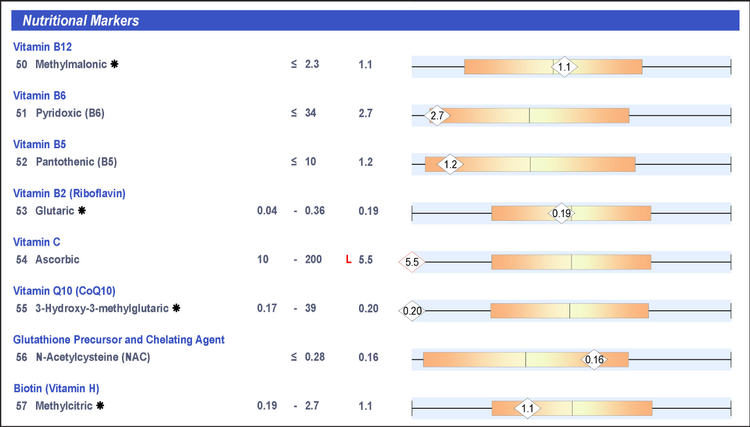Since the creation of the Organic Acid Test, by William Shaw, PhD, many people have found answers to lingering health questions that could not otherwise be explained.
To many seasoned and new practitioners, the wonders of the OAT have been known, but oftentimes practitioners still pose the question…

When should I run an OAT?
This is a valid question as this profile can seem intimidating the first time you see it. With GPL-provided education and supportive consults via the FxMed Technical Support Team, the OAT is a useful tool for any client. In some cases, you’ll see a client with chronic disease that isn’t well supported with traditional therapies. Or maybe you will come across a client who you feel stumped on, or you feel uncertain or where to start your investigation of the root cause of disease. In other cases, you may have someone just looking to prevent disease that runs in their family. In any case, the OAT will shed light on the health situation at hand.
To begin, let’s understand why we should run the OAT. Let’s unpack its purpose and what information you will learn. At its core, the OAT is a metabolic profile that informs us about a wide range of body functions. Gastrointestinal fungal and bacterial overgrowth are assessed with specific Clostridia and mold biomarkers in the first section. Next oxalate formation and mitochondrial function are assessed. Then you get an understanding of neurotransmitter status. On page 4 of the OAT report, there is a comprehensive nutritional profile. Additionally, the indicators of detoxification section clue us into how well someone can handle their toxic burden.

With all this information from one urine sample, how could you not consider assessing this profile for most of your clients. For more information on these sections review 10 Reasons To Do an Organic Acids Test by Kurt Woeller, DO.
Again and again, we’re asked: What conditions are best supported by the OAT? The fortunate news is OAT is beneficial to help diagnose numerous conditions. Because this is a metabolic profile, the results will show you how the person’s body is responding on a metabolic level to any condition they are suffering from. Whether it be a grouping of mysterious symptoms, a confirmed diagnosis of some sort, or a normal life phase like menopause, the OAT guides you in diagnosing and treating a wide range of conditions. To narrow things down there are a few conditions we often see well supported by using this report:
Autism Spectrum Disorders
ADHD
Depression
Anxiety
Parkinson’s
Alzheimer’s
Cognitive decline
Generalized malaise and fatigue along with chronic pain are conditions for which people often seek support.
In neurologic conditions like Parkinson’s disease, the Organic Acid Test has shown itself to be helpful repeatedly. When viewing the neurotransmitter section, keep your eye on number 35, the HVA/VMA ratio. This marker assesses the function of the Dopamine Beta Hydroxylase enzyme (DBH). This enzyme converts dopamine to norepinephrine/epinephrine.
Under hypo functioning states many neurologic conditions arise including Parkinson’s disease (5). Genetic polymorphisms in this enzyme’s functionality have been shown to contribute to the development of this diagnosis. DBH deficiency is also linked to Alzheimer’s, PTSD, ADHD, POTS, Depression, Autism (6), and schizophrenia (1). The presence of clostridia toxins in markers 15, 16, and 17 can also block DBH (6). Cases like this cause the same type of symptoms as the genetic disease. In relation to chronic pain, oxalates are highly implicated. Research has linked oxalates to vulvar pain syndrome as an irritant (4). Oxalate crystals also deposit in the joints and other tissues causing irritation and pain (3).
AUTOIMMUNE & DERMATOLOGICAL CONDITIONS & THE OAT
Other conditions that you can glean information from the Organic Acid Test include autoimmune conditions and dermatological complaints. I have seen various cases of eczema be healed as a result of the information revealed in this profile. Often it was due to mold, candida, or other GI bacterial dysbiosis and overgrowth with poor detox abilities and nutritional deficiencies (2). One case showed elevated detox markers with no signs of mold or GI involvement. In this case the child was bathing in contaminated water by a toxin found on the GPL-TOX Profile. Marker 24 was elevated, and this led us to look at that report. Herpes virus recurrence was once a consequence of mold colonization found on the OAT. Hashimoto’s thyroiditis and a case of autoimmune alopecia in a child were well supported with the use of the OAT.
I have also seen a handful of multiple sclerosis and ALS cases. In these cases, various causes and contributing factors have been alluded to and concluded using the OAT. Sometimes mold was the culprit, other times clostridia was involved. In some cases, chemicals and metals were the cause along with mitochondrial impairment. The more we do the OAT in complex diagnoses like these, the more we can make new connections that may not have been available before.
“The more you complete the OAT profile the more doors will be opened in the treatment and support of various conditions."
So, as you can see the Organic Acid Test isn’t a test for only a handful of diagnoses and symptom pictures. It is a metabolic profile that helps us understand what is affecting the body and how we can metabolically respond. This helps us as practitioners to best support each client in their healing journey.
Because the OAT is a metabolic profile, you don’t have to limit its use to only those that are not feeling well. Oftentimes, people find themselves curious about how healthy they are. They ask themselves: is a healthy diet, exercise, supplements, and meditation helping my body to work better? Am I really doing all I can to prevent disease? On the other hand, you have individuals who don’t necessarily incorporate healthy living habits and want to know where they stand. In some cases, you will have the client with an aged parent with a chronic disease and they want to understand what they can do to potentially prevent themselves from developing it.
When circumstances like these presents themselves, it is a great idea to add an OAT. Even if this is the only test you run, the information is invaluable. In some cases, I have seen results from people with no health complaints that showed increased mold growth or mitochondrial distress. Cases like these have helped with the prevention of disease. People were feeling well enough to test and remediate their home, then to undergo the detox protocol without a whole gambit of unfavorable symptoms. These are the cases where preventative medicine thrives. We should all be aiming to encourage clients to be proactive in their health and to get these wellness checks regularly so we don’t have to be reactive when disease arises.
Other circumstances can sometimes, let’s be honest, leave us feeling stuck as practitioners. After gathering all pertinent current and past medical history we find ourselves sometimes stumped. The person in front of us has a long history of many symptoms that can seem a mile, or two, long. This can be overwhelming, especially when they bring in completed traditional lab work that all reads normal or is well controlled on supplements or medication. Sometimes we ask ourselves, “Where do I start from here?” Often in these situations I find the OAT a great place to start. The way I describe the OAT is like a road map. This report will open new areas for you to stop and dig deeper. It will guide you in a direction you may have never thought to consider. Support also comes when it closes some doors that you’ve been considering or treating long term with little to no success. Profiling clients with the OAT gives you confirmation of your suspicions, new directions to consider, and an overall metabolic picture so you can support that person the way their body is asking to be supported.
At the end of the day, or end of history taking, the Organic Acid Test should be on the forefront of your mind as a practitioner. Really any client should be offered to take this worthwhile test. From your chronic disease patient to your “I just want to stay healthy” patient everyone will benefit. If you still find yourself asking “When do I run the OAT?” Keep in mind neurologic disease, autoimmune disease, chronic fatigue, pain, and autistic communities. In any case, adding the OAT will be a benefit to anyone, you offer it to.
- Gonzalez-Lopez, E., & Vrana, K. E. (2019, October 15). Dopamine beta-hydroxylase and its genetic variants in human health and disease. Wiley Online Library. Retrieved June 24, 2022, from https://onlinelibrary.wiley.com/doi/full/10.1111/jnc.14893
- Hope, J. (2013, April 18). A review of the mechanism of injury and treatment approaches for illness resulting from exposure to water-damaged buildings, Mold, and Mycotoxins. The Scientific World Journal. Retrieved June 24, 2022, from https://www.ncbi.nlm.nih.gov/pmc/articles/PMC3654247/
- Lorenz, E. C., Michet, C. J., Milliner, D. S., & Lieske, J. C. (2013, July). Update on oxalate Crystal Disease. Current rheumatology reports. Retrieved June 24, 2022, from https://www.ncbi.nlm.nih.gov/pmc/articles/PMC3710657/
- R; B. M. S. S. E. H. J. (n.d.). Urinary oxalate excretion and its role in vulvar pain syndrome. American journal of obstetrics and gynecology. Retrieved June 24, 2022, from https://pubmed.ncbi.nlm.nih.gov/9322615/
- Shao, P., Yu, Y.-X., & Bao, J.-X. (2016, May 13). Association of dopamine beta-hydroxylase (DBH) polymorphisms with susceptibility to Parkinson’s disease. Medical science monitor: international medical journal of experimental and clinical research. Retrieved June 24, 2022, from https://www.ncbi.nlm.nih.gov/pmc/articles/PMC4915320/
- W; S. (n.d.). Elevated urinary glyphosate and clostridia metabolites with altered dopamine metabolism in triplets with autistic spectrum disorder or suspected seizure disorder: A case study. Integrative medicine (Encinitas, Calif.). Retrieved June 24, 2022, from https://pubmed.ncbi.nlm.nih.gov/28223908/#:~:text=Excessive%20dopamine%2C%20caused%20by%20inhibition,elements%20such%20as%20the%20neurofibrils.
Share:
Related Posts

Goodbye Pie Chart, Hello Phase 1 Sliders
Written by Allison Smith, ND | 2025 As we usher in a new era of DUTCH testing which leaves behind the concept of the three-way

Introducing the DUTCH Dozen
Written by Kelly Ruef, ND | 2025 Hormone testing can be complex, which is why Precision Analytical developed the DUTCH Dozen, an interpretive framework that

DUTCH Report Enhancements
Written by Hilary Miller, ND | 2025 Precision Analytical have released the newest version of the DUTCH Test. This is the report’s most significant update

Gallbladder Health 101: What It Does and How to Keep It Working Well
Written by Ashley Palmer & Pooja Mahtani | 2025 The gallbladder may not get much attention compared to the gut, but it plays a central

Can You Bring Vitamins on a Plane? How To Travel with Supplements
Written by Austin Ruff | 2024 Are you traveling for a work conference, an athletic competition, or a weekend getaway? Just because you’re leaving home


